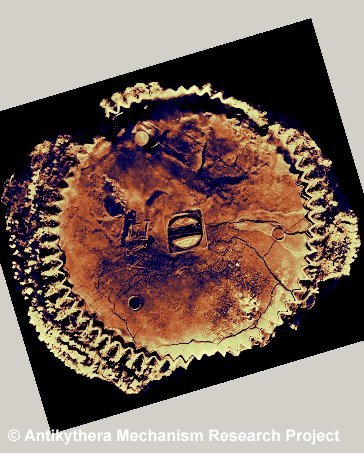

All photographs, radiographs and CT images of the Antikythera Mechanism on this site are owned by the Antikythera Mechanism Research Project and are © Antikythera Research Mechanism Project.

Photograph (composite) of all the last known remaining fragments of the Antikythera Mechanism. As part of the Antikythera Reasarch Project high resolution photographs were taken of all the Fragments. The pictures were taken by Costas Xenikakis and subsequently digitized by Tony Freeth. The highest resolution used was 4,000 dpi at 24-bit depth, giving an uncompressed TIFF file of about 22 Megapixels for each image.


2D CT slices through Fragment A of the Antikythera Mechanism showing just some of the gears on two different levels, or planes through the geartrain. Fragment A contains 27 gears.

2D CT Slice through Fragment B of the Antikythera Mechanism. This slice shows part of the upper back dial, the dial is in the form of a spiral, with 47 divisions per turn, displaying the 235 months of the 19 year Metonic cycle. Part of the smaller subsidary dial can be seen which displays the 76 year Callippic cycle. (There are 4 Metonic cycles within 1 Callippic cycle.)

2D CT Slice (Detail) through Fragment C of the Antikythera Mechanism. This clearly shows some of the divisions on the scales. The Mechanism is though to be the first known instrument that used such scales.

2D CT Slice through Fragment D of the Antikythera Mechanism.

2D CT Slice through Fragment F of the Antikythera Mechanism. This slice shows part of the lower back dial, The dial is in the form of a spiral, with 223 divisions showing the Saros eclipse cycle. Part of the smaller subsidary dial can be seen which displays the 54 year Exeligmos cycle. (There are 3 Saros cycles within 1 Exeligmos cycle.)

2D CT Slice through Fragment G of the Antikythera Mechanism. The power of X-Tek's CT to allow characters to be read from within the fragments has been essential in advancing knowledge of the Mechanism. In the case of Fragment G this is exemplary: Price (1974) notes that its inscription is “almost illegible’, reading only 180 characters. The CT images, viewed at various angles, enabled the research project to read 932 characters.

2D CT Slice through Pointer-Follower found in the Metonic dial within Fragment B of the Antikythera Mechanism. The discovery of this device was key in determining the the back dials are spiral, not circular. This was subsequently supported by the discovery of the word "spiral" in the inscriptions.

Putting it all together, CT Slices and Geometry of the Antikythera Mechanism. A composite of fragments A, B, E and F. The Metonic calendar is at top, with its subsidiary Callippic dial. The Saros eclipse cycle is below, with its subsidiary Exeligmos dial.

Putting it all together, CT Slices and Radiographs of the Antikythera Mechanism. Another composite of fragments A, B, E and F.

Latest Gear Diagram for Antikythera Mechanism. A schematic sectional diagram (not to scale) of the gearing, following the style of Price and Wright. The viewpoint is looking down from the top right of the mechanism, and is stretched in the direction of the main axes to show the structure. Features that are outlined or labelled in red are hypothetical. Gears are lettered with their shaft, and numbered with increasing distance from the front dial. The two-or-three digit number on the gear is its actual or assumed tooth count.
For more about X-Tek's inspection of the Antikythera Mechanism please email antikythera@xtekxray.com.
Further information can be found on the Antikythera Mechanism Research Project website.
The Antikythera Research Project is a joint programme between Cardiff University, Athens University, Aristotle University of Thessaloniki, the National Archaeological Museum of Athens, X-Tek Systems UK and Hewlett-Packard USA, funded by the Leverhulme Foundation.
For more information please contact:
Professor M.G. Edmunds
Cardiff University
E: mge@astro.cf.ac.uk
T: +44 (0)29 2087
4043